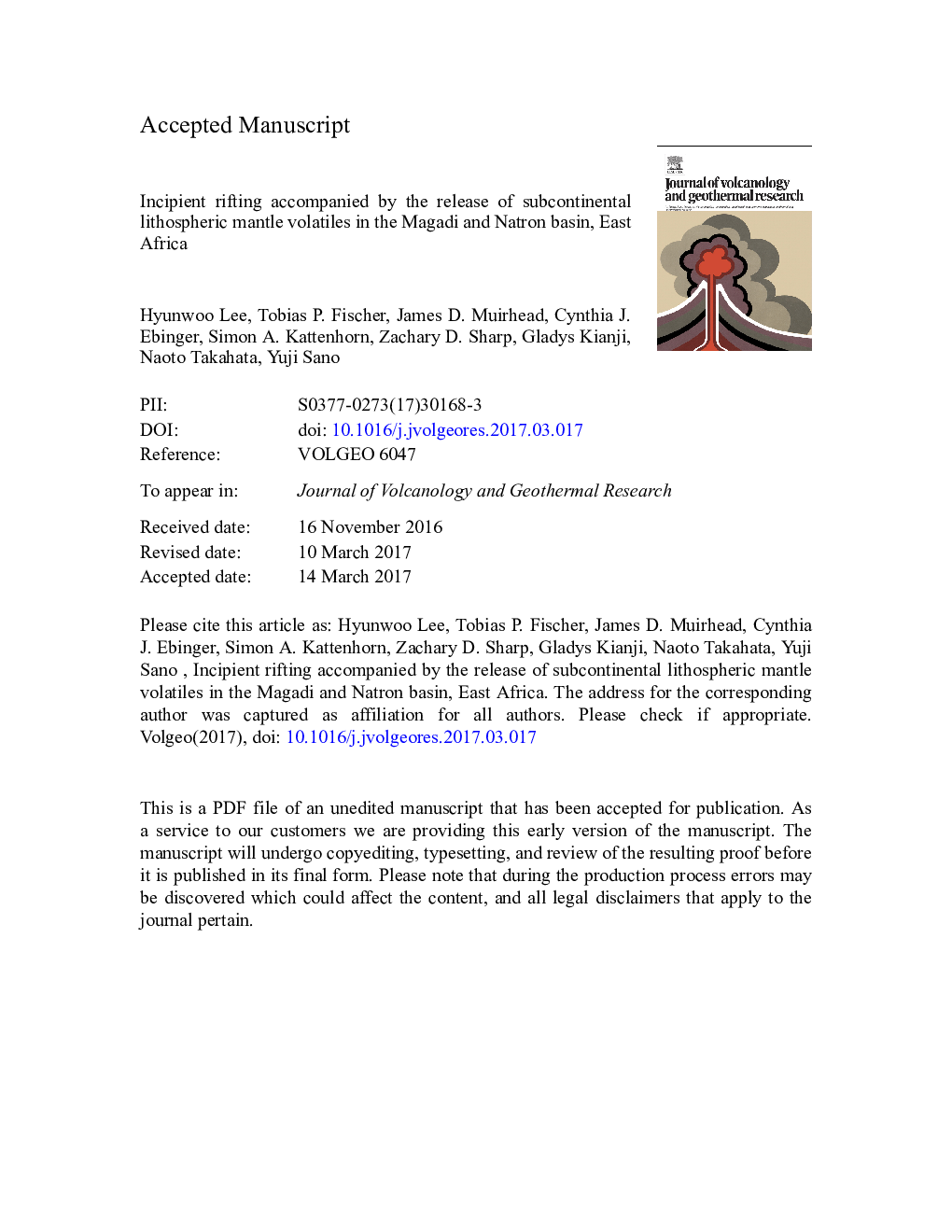| کد مقاله | کد نشریه | سال انتشار | مقاله انگلیسی | نسخه تمام متن |
|---|---|---|---|---|
| 8911484 | 1638277 | 2017 | 73 صفحه PDF | دانلود رایگان |
عنوان انگلیسی مقاله ISI
Incipient rifting accompanied by the release of subcontinental lithospheric mantle volatiles in the Magadi and Natron basin, East Africa
ترجمه فارسی عنوان
ریختن آغازین همراه با پخش فرآورده های گوشته ی شبه کوهستانی زیرین قاره ای در حوضه مگادیه و ناترون، شرق آفریقا
دانلود مقاله + سفارش ترجمه
دانلود مقاله ISI انگلیسی
رایگان برای ایرانیان
کلمات کلیدی
چشمه های حرارتی، فرار ایزوتوپهای پایدار، گازهای نجیب، شارژ، مانت لیتوسفریک زیر قاره ای،
موضوعات مرتبط
مهندسی و علوم پایه
علوم زمین و سیارات
ژئوشیمی و پترولوژی
چکیده انگلیسی
Geochemical investigations of volatiles in hydrothermal systems are used to understand heat sources and subsurface processes occurring at volcanic-tectonic settings. This study reports new results of gas chemistry and isotopes (O, H, N, C, and He) of thermal spring samples (T = 36.8-83.5 °C; pH = 8.5-10.3) from the Magadi and Natron basin (MNB) in the East African Rift (EAR). Although a number of thermal springs are shown to ascend along normal faults and feed into major lakes (Magadi, Little Magadi, and Natron), volatile sources and fluxes of these fluids are poorly constrained. CO2 is the most abundant phase (up to 996.325 mmol/mol), and the N2-He-Ar abundances show a mixture of dissolved gases from deep (mantle-derived) and shallow (air/air saturated water) sources. The H2-Ar-CH4-CO2 geothermometers indicate that equilibrium temperatures range from ~ 100 to ~ 150 °C. δ18O (â 4.4 to â 0.2â°) and δD (â 28.9 to â 3.9â°) values of the MNB thermal waters still lie slightly to the right of the local meteoric water lines, reflecting minor evaporation. Each mixing relationship of N2 (δ15N = â 1.5 to 0.4â°; N2/3He = 3.92 Ã 106-1.33 Ã 109, except for an anomalous biogenic sample (δ15N = 5.9â°)) and CO2 (δ13C = â 5.7 to 1.6â°; CO2/3He = 7.24 Ã 108-1.81 Ã 1011) suggests that the predominant mantle component of the MNB volatiles is Subcontinental Lithospheric Mantle (SCLM). However, N2 is mostly atmospheric, and minor CO2 is contributed by the limestone end-member. 3He/4He ratios (0.64-4.00 Ra) also indicate a contribution of SCLM (R/Ra = 6.1 ± 0.9), with radiogenic 4He derived from a crustal source (R/Ra = 0.02). The MNB 4He flux rates (3.64 Ã 1011 to 3.34 Ã 1014 atoms/m2 s) are significantly greater than the reported mean of global continental flux values (4.18 Ã 1010 atoms/m2 s), implying that magma intrusions could supply mantle 4He, and related heating and fracturing release crustal 4He from the Tanzanian craton and Mozambique belt. Total flux values (mol/yr) of 3He, N2, and CO2 are 8.18, 4.07 Ã 107, and 5.31 Ã 109, which are 1.28%, 2.04%, and 0.24% of global fluxes, respectively. Our results suggest that the primary source of magmatic volatiles in the MNB is SCLM, with additional crustal contributions, which is different from the KRV volatiles that have more asthenospheric mantle components. Volatiles from SCLM in magmas stall in the crust to heat and fracture country rock, with accompanying crustal volatile release. These volatile signatures reveal that MORB-type mantle replaces a relatively small volume of SCLM during incipient rifting (< 10 Ma) in the EAR.
ناشر
Database: Elsevier - ScienceDirect (ساینس دایرکت)
Journal: Journal of Volcanology and Geothermal Research - Volume 346, 15 October 2017, Pages 118-133
Journal: Journal of Volcanology and Geothermal Research - Volume 346, 15 October 2017, Pages 118-133
نویسندگان
Hyunwoo Lee, Tobias P. Fischer, James D. Muirhead, Cynthia J. Ebinger, Simon A. Kattenhorn, Zachary D. Sharp, Gladys Kianji, Naoto Takahata, Yuji Sano,
